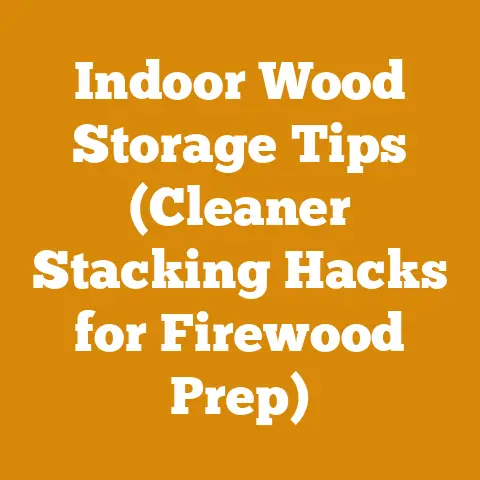Wood Burner Too Hot? (5 Pro Tips for Safe Firewood Use)
Have you ever felt the unsettling heat radiating from your wood stove, a heat that makes you question if you’re just enjoying a cozy fire or flirting with disaster? I know I have. There’s nothing quite like the sinking feeling that creeps in when you suspect your wood burner is running too hot. It’s more than just discomfort; it’s a nagging worry about safety, efficiency, and the longevity of your stove. That feeling of helplessness is something I’m intimately familiar with, especially after a near miss with a chimney fire years ago. Since then, I’ve made it my mission to understand the nuances of firewood and wood-burning stoves.
This article isn’t just about avoiding overheating; it’s about mastering the art of safe and efficient wood burning. I’m going to share five essential pro tips, gleaned from years of experience and research, that will help you control your fire, safeguard your home, and get the most out of your firewood. Let’s dive in and transform that anxious heat into a warm, confident glow.
Wood Burner Too Hot? (5 Pro Tips for Safe Firewood Use)
A wood burner running too hot is a serious concern, not only for the structural integrity of your stove and chimney but also for the safety of your home. Understanding how to manage your fire effectively is crucial. These five pro tips, rooted in both practical experience and scientific understanding, will guide you towards safer and more efficient wood burning.
1. Master the Art of Wood Selection: The Foundation of a Safe Fire
The type of wood you burn is the single most significant factor influencing the heat output and overall safety of your wood burner. It’s not just about grabbing any old log; it’s about understanding the inherent properties of different wood species and how they affect combustion.
Understanding Wood Density and BTU Output
Wood density directly correlates with its heat value, measured in British Thermal Units (BTUs). Hardwoods, like oak, maple, and ash, are denser than softwoods, such as pine, fir, and spruce. This density translates to a higher BTU output per pound of wood.
- Hardwoods: Typically range from 20 to 30 million BTUs per cord. Oak, for example, can produce around 24 million BTUs per cord.
- Softwoods: Generally produce 12 to 18 million BTUs per cord. Pine, a common softwood, yields approximately 16 million BTUs per cord.
Personal Story: I learned this lesson the hard way early on. Eager to save money, I burned primarily pine. Not only did I have to constantly feed the fire, but the creosote buildup in my chimney was alarming. The cost savings were quickly negated by the increased risk and the need for more frequent chimney cleanings.
The Importance of Seasoning: Moisture Content Matters
Freshly cut wood, known as green wood, contains a high moisture content, often exceeding 50%. Burning green wood is inefficient because a significant portion of the fire’s energy is used to evaporate the water, resulting in less heat and increased smoke. This smoke contains creosote, a flammable substance that accumulates in the chimney and poses a significant fire hazard.
- Seasoned Wood: Should have a moisture content below 20%. This typically requires air-drying for 6-12 months, depending on the climate and wood species.
- Testing Moisture Content: Use a moisture meter to accurately measure the moisture content of your firewood. These devices are relatively inexpensive and can save you a lot of headaches.
Data Point: Studies by the EPA have shown that burning seasoned wood can reduce creosote emissions by as much as 80% compared to burning green wood.
Cost Implications of Wood Selection
While hardwoods may be more expensive upfront, they often provide a better long-term value due to their higher heat output and cleaner burning characteristics. Consider the following cost factors:
- Price per Cord: Hardwoods typically cost more per cord than softwoods. For example, in my region, a cord of seasoned oak might cost $300-$400, while a cord of pine might cost $200-$300. (These are estimates, prices vary widely based on location and demand.)
- Burning Rate: You’ll need to burn significantly more softwood to achieve the same heat output as hardwood. This increased burning rate can offset any initial cost savings.
- Maintenance Costs: Burning green or softwood increases the risk of creosote buildup, requiring more frequent chimney cleanings. A professional chimney sweep typically charges $150-$300 per cleaning.
Actionable Tip: Create a spreadsheet to track your firewood consumption and costs. Compare the cost per BTU for different wood species to determine the most economical option for your needs. This is a small investment of your time that can make a big difference in your wallet.
Sustainable Wood Sourcing
Consider sourcing your firewood from sustainable sources. This not only benefits the environment but can also ensure a consistent supply of high-quality wood.
- Local Firewood Suppliers: Look for local suppliers who practice sustainable forestry.
- Tree Trimming Services: Contact local tree trimming services; they often have wood available at a lower cost.
- Harvesting Your Own: If you have access to land, consider harvesting your own firewood, but be sure to obtain any necessary permits and follow sustainable harvesting practices.
Personal Experience: I started harvesting my own firewood a few years ago. It’s hard work, but it’s incredibly rewarding. I’ve learned a lot about forest management and the importance of sustainable harvesting. Plus, it’s a great workout!
2. Control Your Airflow: The Key to a Balanced Burn
Airflow is the maestro of your wood-burning stove, dictating the intensity and efficiency of the combustion process. Mastering airflow control allows you to fine-tune the fire, preventing overheating and maximizing heat output.
Understanding Airflow Mechanisms
Most wood-burning stoves have primary and secondary air controls.
- Primary Air: Enters the firebox near the bottom, providing oxygen for the initial combustion of the wood.
- Secondary Air: Enters the firebox higher up, promoting the combustion of gases and smoke, leading to a cleaner and more efficient burn.
Data Point: Efficient wood stoves, designed with advanced airflow controls, can achieve combustion efficiencies of 70-80%, compared to older, less efficient stoves that may only reach 40-50%.
Adjusting Airflow for Different Stages of the Fire
- Starting the Fire: Open both primary and secondary air controls fully to provide ample oxygen for ignition.
- Establishing the Fire: Gradually reduce the primary air intake as the fire establishes itself.
- Maintaining the Fire: Fine-tune the secondary air control to achieve a steady, clean burn.
Caution: Avoid completely closing the air controls, as this can lead to smoldering combustion, producing excessive smoke and creosote.
Recognizing Signs of Overheating
- Excessive Heat Radiation: The stove surface becomes extremely hot to the touch.
- Glowing Stove Parts: Certain parts of the stove, such as the flue collar, may begin to glow red.
- Roaring Sound: A loud, roaring sound indicates excessive airflow and rapid combustion.
Immediate Action: If you notice any of these signs, immediately reduce the primary air intake and, if necessary, add larger pieces of wood to slow down the burning rate.
Optimizing Airflow for Different Wood Species
Different wood species require different airflow settings.
- Hardwoods: Generally require less primary air than softwoods due to their higher density and slower burning rate.
- Softwoods: Burn more quickly and may require more primary air to maintain a consistent flame.
Personalized Tip: Keep a log of your airflow settings for different wood species. This will help you develop a better understanding of your stove and how to optimize its performance. I have a small notebook next to my stove where I jot down notes on the wood I’m burning and the corresponding airflow settings. It’s been invaluable in fine-tuning my burning technique.
The Cost of Inefficient Airflow
Inefficient airflow can lead to several cost-related issues:
- Increased Firewood Consumption: You’ll need to burn more wood to achieve the same level of heat.
- Higher Chimney Cleaning Costs: Increased creosote buildup requires more frequent chimney cleanings.
- Potential Stove Damage: Overheating can damage your stove, leading to costly repairs or even replacement.
Actionable Strategy: Invest in a good quality stove thermometer. Monitor the flue gas temperature to ensure it stays within the manufacturer’s recommended range. This will help you optimize airflow and prevent overheating.
3. Monitor Stove Temperature: Your Real-Time Safety Gauge
Just like a car’s dashboard provides vital information about its performance, a stove thermometer acts as your real-time safety gauge for your wood burner. It allows you to monitor the stove’s temperature, ensuring it operates within safe and efficient parameters.
Types of Stove Thermometers
There are two primary types of stove thermometers:
Understanding Temperature Ranges
- Creosote Formation Zone: Below 250°F (121°C): Incomplete combustion occurs, leading to excessive smoke and creosote buildup.
- Optimal Operating Range: 250°F – 500°F (121°C – 260°C): Efficient combustion with minimal creosote formation.
- Overheating Zone: Above 500°F (260°C): Increased risk of stove damage and chimney fire.
Data Point: Studies have shown that maintaining flue gas temperatures within the optimal range can reduce creosote buildup by up to 70%.
Interpreting Temperature Readings
- Low Temperatures: Indicate insufficient airflow or wet wood.
- High Temperatures: Suggest excessive airflow or burning too much wood at once.
- Fluctuating Temperatures: May indicate inconsistent wood quality or erratic airflow.
Personalized Insight: I’ve found that the type of wood I’m burning greatly affects the temperature readings. Hardwoods tend to produce a more consistent and higher temperature than softwoods. I adjust my airflow accordingly to maintain the optimal temperature range.
Cost-Saving Benefits of Temperature Monitoring
- Reduced Firewood Consumption: By maintaining optimal temperatures, you’ll burn less wood to achieve the same level of heat.
- Lower Chimney Cleaning Costs: Minimizing creosote buildup reduces the frequency of chimney cleanings.
- Extended Stove Lifespan: Preventing overheating protects your stove from damage, extending its lifespan.
Actionable Step: Install a stove thermometer and monitor it regularly. Keep a log of temperature readings and correlate them with your airflow settings and wood species. This will help you develop a deeper understanding of your stove and how to operate it safely and efficiently.
Investing in a High-Quality Thermometer
While inexpensive thermometers are available, investing in a high-quality, accurate thermometer is a worthwhile investment. Look for thermometers with clear, easy-to-read displays and durable construction.
Cost Consideration: A good quality stove thermometer typically costs between $20 and $50. While this may seem like an unnecessary expense, it can save you hundreds of dollars in firewood costs, chimney cleaning fees, and potential stove repairs.
4. Load Wood Strategically: Fueling the Fire Wisely
The way you load wood into your stove significantly impacts the fire’s intensity, efficiency, and overall safety. Strategic wood loading can prevent overheating, promote cleaner burning, and maximize heat output.
Different Loading Techniques
- Top-Down Loading: Place larger pieces of wood at the bottom of the firebox and smaller pieces on top. This allows the fire to burn downwards, resulting in cleaner combustion and reduced smoke.
- Front-to-Back Loading: Load wood from the front to the back of the firebox, creating a deep fuel bed. This is suitable for maintaining a long, slow burn.
- Side-to-Side Loading: Load wood from side to side, leaving space for airflow. This is ideal for achieving a more intense, shorter burn.
Personalized Tip: I prefer the top-down loading method. I find that it produces less smoke and creosote, and it’s easier to control the fire’s intensity.
The Importance of Airflow Space
Regardless of the loading technique you choose, it’s crucial to leave adequate space for airflow around the wood. This allows oxygen to reach the fire, promoting complete combustion and reducing smoke.
- Avoid Overloading: Do not overload the firebox with wood. This restricts airflow and can lead to smoldering combustion.
- Arrange Wood Loosely: Arrange the wood in a loose, open manner, allowing air to circulate freely.
Wood Size and Shape
The size and shape of the wood also affect the fire’s behavior.
- Smaller Pieces: Ignite more quickly and burn more intensely.
- Larger Pieces: Burn more slowly and provide a longer-lasting heat output.
- Split Wood: Split wood dries more quickly and burns more efficiently than round wood.
Data Point: Studies have shown that burning split wood can increase combustion efficiency by up to 20% compared to burning round wood.
Cost-Effective Wood Loading Practices
- Maximize Firebox Capacity: Fill the firebox to its maximum capacity without overloading it. This will reduce the frequency of reloading.
- Use a Variety of Wood Sizes: Combine smaller pieces for quick ignition with larger pieces for sustained heat output.
- Strategic Placement: Place larger pieces of wood towards the back of the firebox and smaller pieces towards the front. This will help maintain a consistent burn.
Actionable Strategy: Experiment with different loading techniques to find the one that works best for your stove and your wood supply. Keep a record of your findings and adjust your loading practices accordingly.
The Economics of Efficient Wood Loading
Efficient wood loading can have a significant impact on your firewood costs.
- Reduced Firewood Consumption: By maximizing combustion efficiency, you’ll burn less wood to achieve the same level of heat.
- Lower Chimney Cleaning Costs: Minimizing smoke and creosote reduces the frequency of chimney cleanings.
- Extended Stove Lifespan: Preventing overheating protects your stove from damage, extending its lifespan.
Cost Consideration: Even a small improvement in combustion efficiency can translate to significant savings over the course of a heating season. For example, a 10% improvement in efficiency could save you $50-$100 in firewood costs per year.
5. Regular Maintenance and Inspection: A Stitch in Time Saves Nine (and Your Home)
Regular maintenance and inspection are paramount to ensuring the safe and efficient operation of your wood burner. Neglecting maintenance can lead to serious safety hazards, including chimney fires, carbon monoxide poisoning, and stove damage.
Chimney Inspections and Cleaning
- Frequency: The National Fire Protection Association (NFPA) recommends that chimneys be inspected at least once a year and cleaned as needed.
- Professional vs. DIY: While some homeowners choose to clean their own chimneys, it’s generally recommended to hire a professional chimney sweep.
- Cost: A professional chimney sweep typically charges $150-$300 per cleaning.
Data Point: According to the U.S. Fire Administration, chimney fires are a leading cause of residential fires, resulting in significant property damage and injuries.
Personal Experience: I had a close call with a chimney fire several years ago. I had been neglecting my chimney maintenance, and the creosote buildup had become dangerously thick. Fortunately, I caught the fire early and was able to extinguish it before it spread to the rest of the house. Since then, I’ve been diligent about chimney inspections and cleanings.
Stove Inspections
- Frequency: Inspect your stove regularly, at least once a month during the heating season.
- Check for Cracks: Look for cracks in the stove body, door, and flue collar.
- Inspect the Gaskets: Ensure that the door and window gaskets are in good condition and provide a tight seal.
- Examine the Baffle: Check the baffle for damage or deterioration.
Cost Implication: Replacing damaged stove components can be expensive. A new door gasket might cost $20-$50, while a new baffle could cost $100-$300.
Creosote Management
- Understanding Creosote: Creosote is a flammable substance that forms when wood smoke condenses in the chimney.
- Prevention: Burning seasoned wood, maintaining proper airflow, and operating your stove within the optimal temperature range can help prevent creosote buildup.
- Removal: Regular chimney cleanings are essential for removing creosote.
Actionable Step: Keep a record of your chimney inspections and cleanings. This will help you track creosote buildup and schedule cleanings as needed.
Carbon Monoxide Safety
- Carbon Monoxide (CO): A colorless, odorless gas that can be deadly.
- CO Detectors: Install carbon monoxide detectors on every level of your home, especially near sleeping areas.
- Symptoms of CO Poisoning: Headache, dizziness, nausea, vomiting, confusion, and loss of consciousness.
Critical Information: If you suspect carbon monoxide poisoning, evacuate your home immediately and call 911.
The Economic Benefits of Regular Maintenance
- Reduced Fire Risk: Preventing chimney fires can save you from costly property damage and potential injuries.
- Extended Stove Lifespan: Regular maintenance can extend the lifespan of your stove, saving you the cost of replacement.
- Improved Efficiency: A well-maintained stove operates more efficiently, reducing firewood consumption and saving you money.
Cost-Benefit Analysis: While regular maintenance may seem like an added expense, it’s a worthwhile investment that can save you money in the long run. The cost of a chimney cleaning is far less than the cost of repairing fire damage or replacing a damaged stove.
These five pro tips are not just about preventing your wood burner from running too hot; they are about creating a safe, efficient, and enjoyable wood-burning experience. By mastering wood selection, controlling airflow, monitoring stove temperature, loading wood strategically, and maintaining your stove diligently, you can transform your wood-burning stove from a potential hazard into a reliable and cost-effective heating source.
Remember, knowledge is power. The more you understand about your wood, your stove, and the combustion process, the better equipped you’ll be to manage your fire safely and efficiently. So, take the time to learn, experiment, and fine-tune your burning technique. Your home, your wallet, and your peace of mind will thank you for it.






